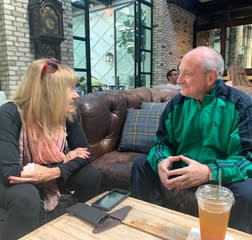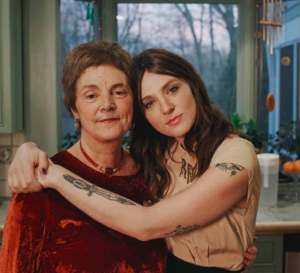Iris Ruth Pastor's Blog, page 25
May 7, 2021
A Mother’s Day Message to my Sons

Dear Harry, Frank, Max, Sam and Louie,
Many years have passed
Since this picture was taken.
My nest is no longer crammed
With smelly sneakers,
Discarded bags of half-eaten chips
And crumpled homework papers
Never turned in.
My little birdies have flown away
Leaving me
With an abundance of time
And a much freer schedule.
I’ve come to some conclusions
About the past and how I’ve lived it.
And I decided that often I was the victim
Of my own expert coping skills
And my own smoldering and eternal optimism.
Sometimes, at your expense.
So now I’m evolving into someone more tempered,
More centered – hopefully, more realistic –
As I try to find my way
Through the wilderness of older age.
I’ve decided to let go of useless suffering
And accept that what I did
And what I didn’t do
Under the guise of mothering
Was all that I could do
And could not do
At the time.
At present, I am trying
To understand
Your individual challenges, struggles and lifestyles
By transcending the confines of my own cage
So that I can aid you in this quest called “living”
As you strive to be the best you can be.
I ask for your patience
When I am blinded by my own perspective
And not tuned in enough to yours.
And I ask that you tell me
Both when I falter
And when I rise to the occasion
On your behalf.
I’m filled with so much gratitude
For the wonderful love
With which you have always bestowed upon me
And by your loyalty, trust, patience and forgiveness.
And I’m trying very hard to get comfortable
With what others are able and willing to give
Rather than being awash with always wanting
“Just a little more. “
It’s a constant struggle
To cultivate the garden,
To be satisfied with the harvest –
Whether it’s meager or abundant –
And to understand
In what way I sabotage
And in what way I nurture.
But I’m sticking with the program
Love,
Mom
April 30, 2021
My Gift to You on Mother’s Day
In Greek mythology, Iris was the goddess of the rainbow, a messenger for Zeus and Hera who rode the rainbow as a multicolored bridge from heaven to earth. In ancient times, the Iris was considered a symbol of power and majesty, the three petal segments representing faith, wisdom and valor.
How ironic that since I began writing in 8th grade, I always felt like I was imparting information – long before I knew the origin of my birth name – long before I knew I was the carrier through which insight flowed from one vessel to another.
Mother’s Day will soon be upon us.
Whether you are a mother or not,
Whether you are male, female or androgynous,
Young, middle-aged or just plain old,
Think about this:
Have you ever found yourself giving excellent advice to others, but not being able to follow your very own advice?Psychologist Igor Grossman coined the term “Solomon’s Paradox” after his research showed many people suffered with this conundrum. Dr. Grossman discovered that people reason more wisely about other people’s social problems than about their own.
King Solomon was the king of Israel who built the first Temple in Jerusalem. He was also the second (after his father, David) and last king of a unified Israel, which was at the height of its power during his reign. He is known for stories told in the Bible about his wisdom and was thought of as a great sage. However, King Solomon, though people traveled great distances to seek his counsel, had another side to him not as glittering or admirable.
King Solomon had a reputation for making bad decisions regularly and had an out of control lust for both women and money. He had 100’s of wives and concubines. King Solomon was also influenced by God’s prophecy to him that his kingdom would be divided. He neglected to instruct his only son, Rehoboam, on how to rule and Rehoboam went on to ruin the kingdom. Hence the name, Solomon’s Paradox. Plenty of wisdom for others; but not for oneself.
How can we circumvent this paradox in our own lives?
When faced with a dilemma, pretend a friend comes to you looking for
answers and guidance on what to do in that same particular situation
Tell your friend exactly what you would do in their situation.
Boomerang it. Do what you told your friend to do.
Continually practice being your own best friend


And keep preserving it,
Iris Ruth Pastor
April 23, 2021
Money Isn’t the Only Thing You Can Bank
Headlines and stories of violence and lack of compassion and human decency scream out at me:
Deadly Run-Ins With The Police Show No Pause
Cars Turn into Caskets as the disco-like lights of police cruisers induce ripples of fear in the veins of the apprehended driver
AARP Fights Fraud on Online Shopping Sites and New Social Security Scams
Pfizer Confirms Fake COVID Vaccines Found in Mexico, Poland
New Report Notes Rise In Coronavirus-Linked Anti-Semitic Hate Speech
We are simply not kind to one another. And, sometimes, I think kindness is dead.
Let’s unpack my supposition.
We can start by being more aware of the softer side of life. We can begin by banking memories of kind acts reported in the press and in our local newspapers (for those of us who still read them and get them!) We can begin banking memories of acts of kindnesses shown us personally in the recent past too. Let’s write down our recollections, stick them in a “Kindness Jar” to pull out and access when we need a spirit lift. Let’s deposit regularly – noting who the person was and why they were kind. And when we need that positive emotional poke, it’s there.
The clearest example that comes to my mind is the kindness our postman showed my husband when he was recuperating from back surgery and even a short walk to our mailbox was challenging for him. Our postman, Enrique, noticing my husband’s wobbly and labored-intensive gait, started bringing our mail and packages right to our front porch.
About a year ago, I placed a notice in my weekly Friday newsletter that I was looking for old buttons – the size of a quarter or larger – to sew on my hand-knitted pouches. You all sent in so many buttons that my post office box was overloaded by the volume. You all found them at yard sales stashed in between vintage napkins and handkerchiefs. You all raided your own sewing baskets. You combed through bags of hand-me-downs from long deceased grandmothers and aunts and mailed me what you gathered.
My friend, Tawny, who I have known since first grade, entreated her husband to give up ownership of buttons his late mother had coveted and he had inherited.
My neighbor’s sister-in-law, Lynda, heard I was collecting unusual buttons and when she traveled back to Indiana, she sent me an entire box filled with wooden, plastic, metal and painted buttons.

A friend of my daughter’s-in-law – who happened to own a button company in New York City – shipped me a huge cardboard box brimming with bags of buttons.
And I when I placed a notice on our neighborhood online site looking for someone to sew these buttons on my hand-knitted pouches (I SUCK at sewing), not only did I find someone, but she has consistently refused payment. A total stranger is doing this act of kindness out of the sheer goodness of her heart. In my jar went one word: SHERYL.
My kindness jar is on the window sill closest to my kitchen counter. When I chop up the cucumbers and peppers to toss in my salad, I see its shiny glass contours. The late afternoon sunshine bounces off its clear top. I notice the growing volume of notes lining its walls – documenting yet more acts of kindness extended to me or someone I love.

I can’t wait to reciprocate.
Let’s all think about a kindness that was extended to us and let us do an act of random kindness today as a way of paying it forward.
Keep Preserving Your Bloom
(And, if you think of it, send me a few buttons!!!!)
Iris Ruth Pastor
April 16, 2021
Life, Death and Good Intentions
It all started when my husband’s junior high school “frenemy” was pushed out the rear doors of a moving school bus and hit his head on the concrete curb adjacent to the street. Pushed by my husband, I might add.
Fearing he killed him upon impact, my husband was quite relieved when Mickey rallied. Instead of ending up in the morgue, Mickey and my husband both ended up the following morning in their junior high principal’s office.
“Okay boys,” the principal admonished, “you can take a swat or I can call your parents.” (This was the 1960’s and swats were routinely given out as a means of discipline.) My husband was savvy enough to realize a paddle to his skinny behind was far less daunting than a call to his dad at work. Mickey didn’t agree and wanted to avoid the paddle altogether.
My husband politely asked the principal if he and Mickey could confer privately for a moment and the principal reluctantly agreed.
“The fighting will continue between you and me, Mickey,“ my husband threatened, “and I will kick your butt every day unless you take the swat and our parents don’t get called.”
Mickey gave in.
My husband stepped up to the principal’s left and braced for the swat. It came, but was surprisingly mild.
Mickey went next. And as my husband recalls, he had never seen a swat so mightily delivered. Dust mites flew through the air off Mickey’s khakis, reflected in the sunlight streaming through the nearby window, as tears streamed down Mickey’s face.
That scene was indelibly etched in my husband’s memory and details of it were often repeated to me over the ensuing years of our marriage – a recollection leaden with guilt and laced with regret on my husband’s part.
I guess my husband and I – who attended the same high school and graduated the same year – are lucky. Among our class of more than 700 is a remarkable man, Mark Abrams, who faithfully tends our Class of ‘65 website and daily updates our doings. Our comings. Our goings. Our departures.
About a month ago, we got notice that Mickey was being cared for by hospice in Raleigh, NC, where he has resided since 2015. High school and junior high classmates were virtually gathering to share their memories of Mickey with him. We were unable to take part in the get together, but shortly thereafter I noticed a sea change in my husband.
“You know,” he remarked one morning, “I’ve always felt badly about that incident – beginning with me pushing Mickey off the bus. I’d like to call him and apologize.”
Hours later, after obtaining Mickey’s contact information, my husband did just that.
Many phone calls and texts flew between Mickey and my husband over the following weeks. The surprise? Mickey didn’t even remember the bus incident, my husband’s bullying behavior or the ensuing powerful swat.
A phrase Mickey wrote in one of his many texts to my husband was: “I’m very glad we have renewed an old friendship and that it led to an even better one.”
And my husband replied, “If not for family and friendships, what is life at the core of its essence really all about?”
“So true,” my husband’s former adversary noted.
Four days after sending that text, Mickey passed away.
What did I learn? Best to follow-up on good intentions, for it’s always later than we think.
Keep Preserving Your Bloom,
Iris Ruth Pastor
April 9, 2021
Dating After 45 Years of Marriage
The first thing that happened was that a good friend’s mother died. Okay, not that unusual as my friend is in her 70’s; but we all thought her amazing mother would live forever – after all, she was 106!
The second thing that impacted me was that a friend who we haven’t seen in years had a heart attack while playing tennis and died just a few days later – having never regained consciousness.
That’s when I decided it was time to stop postponing a first date with a very attractive man my age.
We met on a Thursday afternoon at a hip bistro. He ordered a fancy flavored iced tea and I chose a cappuccino. We sat and talked for over an hour – while he nursed his beverage and I wolfed mine down (out of nervousness, I’m sure).
I had prepared a massive list of probing questions – perhaps a little off-putting to him. Nevertheless, he good-naturedly mulled over each one and his answers were laced with interesting tidbits.
Here’s a sampling of what I asked him:
What is something people would be surprised to learn about you?
What’s your ideal vacation?
What are you most grateful for in your life?
What’s your favorite time of day?
What would you consider your biggest fault?
What’s the most valuable lesson you ever learned?
What is one thing about yourself you’d like to change?
What do you look for in a partner?
What’s one thing you wish you knew at age 30 that you know now?
What are three things you want included in your obit?
What do you consider your greatest strength?
What advice would you give for dealing with loss and change?
My final question to him deviated from my carefully constructed format in that it only required a “Yes “or “No” reply.
“Would you like to go out with me again?”
He answered affirmatively.
Before leaving the bistro, we asked one of the servers if she would take a picture of us. She smiled as she handed me back my phone, whispering, “New beginnings are so awesome.”
“Yes,” I said, “especially after 45 years of marriage.”

Keep Preserving Your Bloom,
Iris Ruth Pastor
PS I find that lots of people ask me what I’m reading.
I just started Pachinko by Min Jin Lee, recommended by a member of my book club. It’s billed as an engaging story of a Korean family in Japan and their struggle to achieve a sense of home in this world. It delivers.
Caste: The Origins of our Discontents by Isabel Wilkerson has been on my nightstand forever and I’m about a third of the way through. It’s a book best read in snippets because it prompts much ruminating and self-examination.
I just ordered from Amazon The Empathy Diaries by Sherry Turkle after reading about it in the Sunday edition of the New York Times. It deals with a recurrent issue: finding connection in a time of uncharted challenges.
April 2, 2021
Balancing the Balance
It’s hard to strike a work-life balance – even after the nest empties and the chickadees fly from the perch.
What I’ve learned is not every day has to be exquisitely, or even moderately, balanced. For me, an out-of-whack routine only becomes problematic when it is extended beyond reasonable lengths.
A question of balance also applies to the subjects I choose to write about in my weekly Friday newsletter. I strive consciously for variety – some columns are humorous – some columns are more contemplative – some columns are meant to humorous and turn out less so. Some columns are not meant to be humorous – but are interpreted that way anyway! My point, I plan. I write. And my loyal cadre of readers take from them what they may.
I have noticed, however, over the last couple of months that I have written more frequently about my past eating disorder. This is partly due to National Eating Disorder Awareness Week -which was February 22-28 – and partially due to certain opportunities in the professional eating disorder network that I have been afforded.

Recently I made a guest appearance on a podcast called Processing which explores the intersection of food and grief and is co-hosted by Zahra Tangorra and her mother, Bobbie Comforto.

It’s all about sharing personal stories and how food factors into our journey. As the show’s description notes, “Change and loss are inevitable in all our lives. The relationships that we as humans have surrounding food and loss are universal and relatable across different cultures, beliefs, and lifestyles. It is our individual adaptation to the things we cannot control that makes us unique. Processing will expose and digest these commonalities and differences in each episode.”
Zahra, who lives in Brooklyn, is a chef, writer and podcaster. She owned a Cobble Hill restaurant named Brucie, which was renowned for its lasagna and warm, familial atmosphere. Her mother, Bobbie Comforto, who lives on Long Island, is a psychotherapist specializing in bereavement and trauma. In her early years, she was a chef and owner of a specialty food and catering company.
Below is the link and verbiage on my recent appearance on Processing:
https://podcasts.apple.com/us/podcast/processing/id1494829164?i=1000514401046
I hope you enjoy it.
Keep Preserving Your Bloom,
and Happy Easter,
Iris Ruth Pastor
March 26, 2021
The Most Boring Subject in the World
If you ask my husband what the most boring subject in the world is, he would sum it up in three words: my wife’s weight.
Not to me, of course. For so many years, my mood has been dictated by what the needle on the scale registers. And I have a lot of scales.
This scale is the first one I was ever weighed on. When our family pediatrician retired, he gifted me with the baby scale he used to weigh his newborn patients – including me, my brother and my sister.

Years later working at a non-profit, I was the recipient of an old-fashioned scale the organization was getting rid of. It now holds another one of my obsessions: my stack of “books to read someday.”

I also struggled with how often to actually step on the scale:
Hourly (wow, that’s really excessive)
Daily
Weekly
Monthly
Only at doctor appointments
In October, I signed up for Noom – a health app that provides articles, tools and tracking for progress in weight loss. The program dictates daily weigh-ins. Hence, I had no choice but to devise a routine: Nine AM every day, before my first cup of coffee, I strip off everything – my watch, my nightgown, my hair clips – I mean everything. Except my bikini briefs. And step on the digital truth-teller.

I quickly found that venturing on the digital scale varies little with each additional step-on and step-off. Not like the scale I owned growing up – where the needle bounced around wildly with every sway and gross movement.
How does weighing myself daily affect my mood?
Surprisingly, I have found it liberating. I may not like what it registers, but there are no BIG surprises and the next day is a new day – just twenty-four hours away.
Over the last few months, since I have been happy with my weight, my mood has correspondingly lightened. Clothes shopping is enjoyable again. Trying on clothes in my closet I haven’t dared to try on for years – well, they either fit or hang loosely.
I’m loving it.
But suddenly about two weeks ago, depression descended mightily – a depression I simply couldn’t rid myself from its clutches. Where was this heavy cloud of doom and gloom coming from?
And then I realized – the upcoming holiday of Passover was the source of my angst. Three of my five sons will be together for the first night of Passover with their wives and all my grandchildren. And my husband and I will be one thousand miles away.
Woe is me.
I tried practicing the art of gratitude.
I tried counting my many blessings.
I tried meditation. Deep breathing. Venting to a friend. (Well, a lot of friends, actually.)
Nothing helped reduce my profound sense of longing for wanting to be with them as we read the Haggadah, slurp-up the chicken soup, sip the wine and hide the Afikoman (half a piece of matzo broken in two and hidden).
And the CDC recommendations don’t assuage this untenable situation. As reported in the New York Times, experts are still unsure if vaccinated grandparents can carry Covid to the people they are visiting.
I sought to fine-tune my awareness of my sadness.
I tried to come to an understanding of my thoughts and thought processes.
I sought to look at the same situation in a different way, as I can’t change that they are there and we are here.
Finally, I figured it out and came up with a solution – obvious maybe to others right away, but not to me.
ZOOM! FaceTime. One of those should work. I’ll leave that decision to my sons. All I know is we will be part of their Seder.
Gotta run.
Have to hunt up our Haggadahs, the Seder plate, buy my brisket, bake my matzo meal muffins and decide on dessert. And I’ve got to set the table in the dining room with the good china and silver.
Next year in Connecticut.
Keep Preserving Your Bloom,
Iris Ruth Pastor
March 19, 2021
What Happens When You Lower Your Expectations…
When you lower your expectations
and stop trying to get
from your adult kids
what they are not programmed
to give
(that’s what best buddies
are for BTW)
When you lower your expectation,
and begin reveling
in the gifts of affection, time, forgiveness and patience
they do so readily extend
When you lower your expectations
and stop trying to control
everyone else’s actions
and instead
tend to your own
When you give
without strings
and with wild abandon
embrace what is offered
without editing, revising, yearning and tweaking
It’s surprising
how wonderfully magical
a trip to see
your out-of-town adult sons, their wives and children
can be
I can’t take credit for all my new-found fonts of wisdom.
I’ve been buoyed and aided by some very wise women who came before me:
my mother, the late Bev Levine
my mother-in-law, the late Hotche Pastor
and my aunt, the late Melva Case
Too many good buddies to list
(You know who you are)
and of course, my sister, Lori
Columnist Carolyn Hax
Authors and books:
The Giving Tree
by Shel Silverstein
Don’t Bite Your Tongue
by Dr. Ruth Nemzoff
Programs:
NOOM – the weight loss regimen that strongly fosters honest appraisal of feelings, fears, distortions and roadblocks
Movies
The character Isaac in “The Photograph” who says:
“I don’t recommend getting older. Less people to talk to
More time to go over every regret.”
Keep Preserving Your Bloom,
Iris Ruth Pastor
March 12, 2021
Back to Normal in a Super-Sized Way
Last week, based on a friend’s suggestion, I asked readers to come up with two words each to describe the years 2020 and 2021.
Thank you to all who contributed their opinions. Here is a sampling of responses:
2020
Difficult, trying
Bad, persistent
Totally depressing
Physiopsychosocialspiritual challenge
Naïve population
Long, confining
Covid, pandemic
Disaster, heart-wrenching
Woefully unprepared
Challenging, dark
2021
Still early
Nonsense, annoying
Dumb corona
Cautiously optimistic
Semi-normalcy
Happily vaccinated
Hopeful, sanity
Hopeful, progressive
History bears out the intuitive feeling of optimism and hopefulness that follows a pandemic.
In 1918 and 1919, a global flu pandemic killed 675,000 Americans and in 1920 and 1921, a depression shattered the economy. What happened after? There ensued a long period of unprecedented growth, progress and prosperity, ushering in one of the most innovative periods known today as the Roaring Twenties. Historians feel the huge growth in the U.S. economy was not an anomaly. It was a return to normalcy.
The Roaring Twenties deserves its name—the U.S. economy grew by 42 percent from 1921 to 1929. But economic historians argue that the factors that made the decade so profitable were less of an anomaly than a reprieve from hardship and poverty. People simply exhaled. People gloried in the belief that anything was possible.
Life would simply never be the same. The changes after the 1918 pandemic were ubiquitous and lasting.
Fashion was impacted by the commercial rise of female fashion designers and couturiers. Think Gabrielle “Coco” Chanel, Jeanne Lanvin, Gucci, Elsa Schiaparelli and the house of Fendi.
Flapper fashion was all about getting loose and one observer noted it “applied to looser morals too.” Women’s fashion in the 1920’s centered around dresses with a drop waist, a belt or sash in the area of the hip, and a skirt above the ankle but never – heaven forbid – above the knee. Females of all ages abandoned the corset. Dresses became more revealing, with shorter sleeves and lowered bust lines.

Source: Women’s 1920s Hairstyles: An Overview
“Live for now” was the mindset. And this freedom was also reflected in hairstyles for women. Rebellion reigned against past trends focusing on long hair meticulously and complexly pinned-up. Think the Gibson Girl look.

Short cropped hair became the rage.

Men’s hair also enjoyed a shift to simplicity – becoming less “poofy” and more slicked back to achieve a flatter type of look.

Who doesn’t know who this is?????
In the 1920s, jewelry followed suit: a turn away from fussy Art Nouveau styles and a turn toward simplicity and art deco styles. Out was the mindset to “wear your wealth.” Out was the exclusive use of expensive precious stones. In was the introduction of costume jewelry – utilizing cheaper semiprecious stones and fake plastics. Long pearl necklaces abounded and the introduction of cultured “fake” pearls made this iconic piece of jewelry within reach of many women of lesser means and status.
Bright colors were in vogue. Bangles of Bakelite were embraced by the masses.

And it wasn’t just fashion that broke with tradition and where innovation flourished. The period from 1921 – 1929 ushered in the automobile, the radio, moving pictures, the refrigerator, the electric washing machine, and the jukebox. Historians say that after the pandemic people simply wanted to have fun and spend money. And they did.
Home décor also was impacted in the aftermath of the pandemic.
Brass beds rose in favor, replacing wooden bed frames, headboards and footboards. Why? Because wooden surfaces were difficult to wash down, but brass and iron beds could be cleaned easily with bleach and water.
Clawfoot tubs on legs, though picturesque, were difficult to effectively wash and clean due to multiple surfaces. Built-in tubs had edges sealed against the tiled wall on three sides. – alleviating many crevices and joints that collected dust and grime. Bright white Subway tiles were used to surround the tubs as they also were simpler to clean and maintain.

According to Dr. Jessica Spector, a Yale University professor of alcohol history, cocktails, and ethics, these new inventions brought people together like no other: “You’ve got people listening to the same music and watching the same pictures; all of a sudden people can share a culture.”
As my grandson, Benjy, reminded me: the National Football League (NFL) also began taking serious shape during this time. And football would, in the coming decades, dominate professional sports and be the impetus for great community connections among people in the U.S.
As far as health care systems, around this time, the United States began adopting employer-based insurance plans which expanded access to healthcare to the general public.
Like Covid, during the pandemic, trains were seen as an expedient vessel for transmitting disease so the general public was wary of riding on them. Editorials advised against overcrowding and cautioned citizens to avoid passenger trains as much as possible. With the waning of the Spanish Flu, large numbers of passengers once again felt safe to travel and returned to the trains as a reliable mode of transportation.
Like Covid, during the 1918-19 pandemic, mask wearing became an effective tool for fighting the virus’s spread. And masks became a sign of creativity and individual taste.

Clipping from a “The Seattle Clarion Ledger” 1918 article that opens with “Styles of wearing influenza masks today are many and weird.” (Courtesy Kimberly Alexander).
A cautionary note: there was a short post-Spanish Flu depression in 1920 and 1921, but prosperity and optimism and good times quickly returned. Normal economic growth and the normal economic business cycle roared back – lasting until the 1929 stock market crash – known as The Great Depression – silenced the roar. Will history repeat itself? Who knows. Until then….
My two words to sum up 2021:
Re-inventing, Re-birth
Keep Preserving Your Bloom,
Iris Ruth Pastor
March 5, 2021
Looking backward, forward and staying in the moment
I never lack for ideas but that doesn’t mean I don’t welcome hearing other people’s ideas for my columns.
Here’s one from a friend I just had coffee with –
after not seeing for over 20 years.
Thanks JBuc.
Think quickly:
In two words, describe 2020
In two words, describe 2021
(Try to leave out profanity:)
Thank you.
Send your replies to: irisruthpastor@gmail.com
And now for this week’s column:
It’s been a roller coaster week of emotional ups and downs.
Intense and exhausting.
One family member having surgery
Plus getting the opportunity to spend time with each of my seven grandchildren after so many months of separation.
My four granddaughters and my three grandsons range in age from one year to fourteen years. And I recognize their varying degrees of connection to grandparents as they grow, change and develop:
A one-year-old’s tentativeness
A three-year-old’s adoration
Middle schoolers’ varying interest
Teenagers’ growing preoccupation with friends, social media and the outside world
When my emotions run high, as they did this week, I turn to my Calm App with Tamara Levitt to lower the intensity of my feelings. And this week, I explore more deeply some terms she recently introduced:
Sati,
Hakuna Matata,
Shamatha,
and Gluggavedur
When I first looked up Sati, I was shocked to discover that it was a Hindu practice where upon the widow throws herself upon her deceased husband’s funeral pyre and perishes too. Geez. That’s a little too much sacrifice for me.
I prefer the Buddhism Sati, which is a state of mindfulness. The first step is simply setting an intention to cultivate awareness and to return to that intention again and again. The second is observing your thoughts, feelings and sensations as they arise.
The benefits of mindfulness are many: increased self-control, objectivity, tolerance, flexibility, and equanimity plus improved concentration, mental clarity, and emotional intelligence.
Mindfulness also engenders an increase in kindness, acceptance and compassion for ourselves. It requires us to recollect our experiences with focus, clarity, compassion and acceptance. The result? A lack of judgment or interpretation of past actions viewed through a less harsh lens.

Many have first heard Hakuna Matata from The Lion King and are aware of its meaning: No worries. There are no problems here.
Worrying is a harmful habit that shows up during unwelcome times – like when we are trying to sleep. In The Lion King, Simba blames himself for his father’s death and is ashamed to go back home – a friendly cat, recognizing that Simba has to move forward, introduces him to Hakuna Matata.
Worry can be ingrained. To change, we need to notice when we are worried –– step outside of it – and question if our worry is helpful. Think of worry as useless as “a handle on a snowball.”
From the song:
Hakuna Matata!
What a wonderful phrase
Hakuna Matata!
Ain’t no passing craze
It means no worries
For the rest of your days
Yeah, sing it, kid!
It’s our problem-free philosophy
Hakuna Matata!
Shamatha is a Buddhist term often is translated as tranquility of the mind. This is not to be confused with the Yiddish word schmatta which is an old and ragged piece of clothing!!
Shamatha is slowing down our minds and calming down so we can observe and understand – kinda like disengaging from thinking.
Imagine dirt and water: Dirt settles and becomes less muddy. We then can see what is going on.
Shamatha focuses on the rising and falling of our breath and feeling every drawing in and releasing of it. And when the mind wanders, we bring it back to the breath with the goal of liberation from suffering.
There is no comparable term to Gluggavedur in the English language. Too bad. It literally means “Window Watching Weather.” This means weather that is best appreciated from the comfort of indoors – from a protected distance.
This Icelandic term means weather that is nice to look at, but not nice to be in. Imagine we are safely inside, sipping hot cocoa, while looking out the window during a terrible storm:
Lighting and thunder
Frigid wind and torrential rain
Violently wrenching trees
In a comparable manner, Gluggavedur is a way for us to move through difficult emotions. In mindfulness, we observe our inner storms in the same way we view the storms outside our windows. We create a bit of space around our swirling feelings, which makes us better able to calmly face our sentiments as they arise and subside.

In a month that is known to “come in like a lion and go out like a lamb,” here’s to upcoming weeks of calm both inside and outside our windows.
Keep Preserving Your Bloom,
Iris Ruth Pastor



